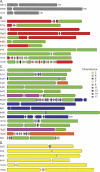Architectures of somatic genomic rearrangement in human cancer amplicons at sequence-level resolution
- PMID: 17675364
- PMCID: PMC1950898
- DOI: 10.1101/gr.6522707
Architectures of somatic genomic rearrangement in human cancer amplicons at sequence-level resolution
Abstract
For decades, cytogenetic studies have demonstrated that somatically acquired structural rearrangements of the genome are a common feature of most classes of human cancer. However, the characteristics of these rearrangements at sequence-level resolution have thus far been subject to very limited description. One process that is dependent upon somatic genome rearrangement is gene amplification, a mechanism often exploited by cancer cells to increase copy number and hence expression of dominantly acting cancer genes. The mechanisms underlying gene amplification are complex but must involve chromosome breakage and rejoining. We sequenced 133 different genomic rearrangements identified within four cancer amplicons involving the frequently amplified cancer genes MYC, MYCN, and ERBB2. The observed architectures of rearrangement were diverse and highly distinctive, with evidence for sister chromatid breakage-fusion-bridge cycles, formation and reinsertion of double minutes, and the presence of bizarre clusters of small genomic fragments. There were characteristic features of sequences at the breakage-fusion junctions, indicating roles for nonhomologous end joining and homologous recombination-mediated repair mechanisms together with nontemplated DNA synthesis. Evidence was also found for sequence-dependent variation in susceptibility of the genome to somatic rearrangement. The results therefore provide insights into the DNA breakage and repair processes operative in somatic genome rearrangement and illustrate how the evolutionary histories of individual cancers can be reconstructed from large-scale cancer genome sequencing.
Figures



Similar articles
-
The FRA2C common fragile site maps to the borders of MYCN amplicons in neuroblastoma and is associated with gross chromosomal rearrangements in different cancers.Hum Mol Genet. 2011 Apr 15;20(8):1488-501. doi: 10.1093/hmg/ddr027. Epub 2011 Jan 21. Hum Mol Genet. 2011. PMID: 21258086
-
Complex landscapes of somatic rearrangement in human breast cancer genomes.Nature. 2009 Dec 24;462(7276):1005-10. doi: 10.1038/nature08645. Nature. 2009. PMID: 20033038 Free PMC article.
-
Identification of somatically acquired rearrangements in cancer using genome-wide massively parallel paired-end sequencing.Nat Genet. 2008 Jun;40(6):722-9. doi: 10.1038/ng.128. Epub 2008 Apr 27. Nat Genet. 2008. PMID: 18438408 Free PMC article.
-
The sources of variation in the human genome and genome instability in human cancers.Rom J Physiol. 1997 Jan-Dec;34(1-4):3-17. Rom J Physiol. 1997. PMID: 9653805 Review.
-
Implications of human genome architecture for rearrangement-based disorders: the genomic basis of disease.Hum Mol Genet. 2004 Apr 1;13 Spec No 1:R57-64. doi: 10.1093/hmg/ddh073. Epub 2004 Feb 5. Hum Mol Genet. 2004. PMID: 14764619 Review.
Cited by
-
Disentangling oncogenic amplicons in esophageal adenocarcinoma.Nat Commun. 2024 May 14;15(1):4074. doi: 10.1038/s41467-024-47619-4. Nat Commun. 2024. PMID: 38744814 Free PMC article.
-
Aneuploidy and complex genomic rearrangements in cancer evolution.Nat Cancer. 2024 Feb;5(2):228-239. doi: 10.1038/s43018-023-00711-y. Epub 2024 Jan 29. Nat Cancer. 2024. PMID: 38286829 Free PMC article. Review.
-
Deciphering complex breakage-fusion-bridge genome rearrangements with Ambigram.Nat Commun. 2023 Sep 8;14(1):5528. doi: 10.1038/s41467-023-41259-w. Nat Commun. 2023. PMID: 37684230 Free PMC article.
-
Long-read sequencing of diagnosis and post-therapy medulloblastoma reveals complex rearrangement patterns and epigenetic signatures.Cell Genom. 2023 Mar 22;3(4):100281. doi: 10.1016/j.xgen.2023.100281. eCollection 2023 Apr 12. Cell Genom. 2023. PMID: 37082141 Free PMC article.
-
A multi-platform reference for somatic structural variation detection.Cell Genom. 2022 Jun 8;2(6):100139. doi: 10.1016/j.xgen.2022.100139. eCollection 2022 Jun 8. Cell Genom. 2022. PMID: 36778136 Free PMC article.
References
-
- Abeysinghe S.S., Chuzhanova N., Krawczak M., Ball E.V., Cooper D.N., Chuzhanova N., Krawczak M., Ball E.V., Cooper D.N., Krawczak M., Ball E.V., Cooper D.N., Ball E.V., Cooper D.N., Cooper D.N. Translocation and gross deletion breakpoints in human inherited disease and cancer I: Nucleotide composition and recombination-associated motifs. Hum. Mutat. 2003;22:229–244. - PubMed
-
- Alsop A.E., Teschendorff A.E., Edwards P.A.W., Teschendorff A.E., Edwards P.A.W., Edwards P.A.W. Distribution of breakpoints on chromosome 18 in breast, colorectal, and pancreatic carcinoma cell lines. Cancer Genet. Cytogenet. 2006;164:97–109. - PubMed
-
- Amler L., Shibasaki Y., Savelyeva L., Schwab M., Shibasaki Y., Savelyeva L., Schwab M., Savelyeva L., Schwab M., Schwab M. Amplification of the N-myc gene in human neuroblastomas: Tandemly repeated amplicons within homogeneously staining regions on different chromosomes with the retention of single copy gene at the resident site. Mutat. Res. 1992;276:291–297. - PubMed
-
- Bignell G.R., Huang J., Greshock J., Watt S., Butler A., West S., Grigorova M., Jones K.W., Wei W., Stratton M.R., Huang J., Greshock J., Watt S., Butler A., West S., Grigorova M., Jones K.W., Wei W., Stratton M.R., Greshock J., Watt S., Butler A., West S., Grigorova M., Jones K.W., Wei W., Stratton M.R., Watt S., Butler A., West S., Grigorova M., Jones K.W., Wei W., Stratton M.R., Butler A., West S., Grigorova M., Jones K.W., Wei W., Stratton M.R., West S., Grigorova M., Jones K.W., Wei W., Stratton M.R., Grigorova M., Jones K.W., Wei W., Stratton M.R., Jones K.W., Wei W., Stratton M.R., Wei W., Stratton M.R., Stratton M.R., et al. High-resolution analysis of DNA copy number using oligonucleotide microarrays. Genome Res. 2004;14:287–295. - PMC - PubMed
-
- Cahill D., Connor B., Carney J.P., Connor B., Carney J.P., Carney J.P. Mechanisms of eukaryotic DNA double strand break repair. Front. Biosci. 2006;11:1958–1976. - PubMed
Publication types
MeSH terms
Substances
Grants and funding
LinkOut - more resources
Full Text Sources
Other Literature Sources
Research Materials
Miscellaneous
